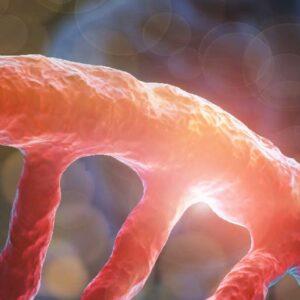Malignant tumors in the liver have either originated in the liver (primary liver cancer) or spread from cancer sites elsewhere in the body (metastatic liver cancer). Most cancerous tumors in the liver are metastatic.
Hepatocellular carcinoma (HCC) is the most common form of primary liver cancer in adults. HCC can have different growth patterns. Some begin as a single tumor that grows larger. Only late in the disease does it spread to other parts of the liver. A second type seems to start as many small cancer nodules throughout the liver, not just a single tumor. This is seen most often in people with cirrhosis (chronic liver damage). Several subtypes of HCC can be classified. Most often these subtypes do not affect treatment or prognosis. But one of these subtypes, fibrolamellar, is important to recognize. It is rare, making up less than 1% of HCCs and is most often seen in women younger than 35. Often the rest of the liver is not diseased. This subtype tends to have a better outlook than other forms of HCC.
Intrahepatic cholangiocarcinoma (bile duct cancer) accounts for about 10% to 20% of cancers that start in the liver. These cancers start in the cells that line the small bile ducts within the liver. Most cholangiocarcinomas, however, actually start in the bile ducts outside the liver. Cholangiocarcinomas are often treated the same way as HCC.
Hepatoblastoma is a very rare kind of cancer that develops in children, usually in those younger than 4 years old. The cells of hepatoblastoma are similar to fetal liver cells. About 2 out of 3 children with these tumors are treated successfully with surgery and chemotherapy, although the tumors are harder to treat if they have spread outside the liver.
GENOMIC ALTERATIONS
FGFR2 fusions are the most frequent FGFR fusions and are particularly common in cholangiocarcinoma. In this regard FGFR2–TACC3 fusions have been frequently described in patients with intrahepatic cholangiocarcinoma. These fusions activate the canonical FGFR signaling and possess oncogenic activity. The FGFR2–CCDC6 fusion has been demonstrated to induce cancer cell proliferation and tumorigenesis in vivo.
POSSIBLE THERAPIES
Many of the targeted drugs used to treat liver cancer are kinase inhibitors. These drugs block several kinase proteins, which normally help tumor cells grow in one of two ways: either by helping tumor cells to grow directly, or by helping tumors to form the new blood vessels they need in order to get bigger (angiogenesis). Blocking these proteins can often help stop the growth of the cancer.
Sorafenib (Nexavar) and lenvatinib (Lenvima) can be used as the first treatment for liver cancer if it cannot be treated by surgery or if it has spread to other organs. Sorafenib may work better in people with liver cancer caused by hepatitis C.
Regorafenib (Stivarga) and cabozantinib (Cabometyx) can be used to treat advanced liver cancer, typically if other treatments are no longer helpful.
Bevacizumab (Avastin) is a monoclonal antibody that targets vascular endothelial growth factor (VEGF), a protein that helps new blood vessels to form. This drug can be used along with the immunotherapy drug atezolizumab (Tecentriq) as the first treatment for liver cancer that cannot be treated by surgery or that has spread to other organs.
Ramucirumab (Cyramza) is a monoclonal antibody that targets a VEGF receptor protein on cells, which can help stop the formation of new blood vessels. This drug can be used to treat advanced liver cancer, typically after another treatment stops working.
FUSION GENE PANEL
FGFR2-CCDC6, FGFR2-TACC3





















